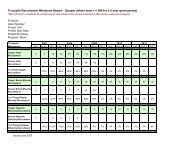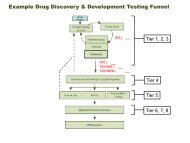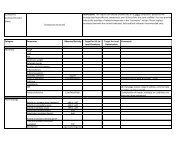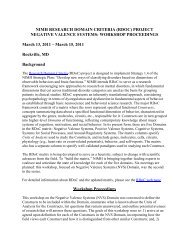Brain's Inner Workings: Teacher's Manual - NIMH
Brain's Inner Workings: Teacher's Manual - NIMH
Brain's Inner Workings: Teacher's Manual - NIMH
Create successful ePaper yourself
Turn your PDF publications into a flip-book with our unique Google optimized e-Paper software.
Finally, students can explore the “simple” reflexes in the activities Take That! and It’s the Thought that<br />
Counts. This section of the module includes two simple computer programs for measuring reaction time.<br />
They are only roughly accurate, but again the results are proportional to those obtained by more specialized<br />
equipment. Professional researchers know that the display of most personal computers creates inherent errors<br />
in reaction time measurement, but these errors are too small to contribute to misunderstandings at this level.<br />
Some reflexes are coordinated in the spinal cord, where grey matter (unmyelinated neurons) connect sensory<br />
and motor neurons. Other reflexes like blinking are coordinated in the midbrain. While scientists hesitate to<br />
classify reflexes as “simple” any more, reflexes are defined as “instantaneous,” so autonomic responses that<br />
take longer (like the “butterfly” reaction that occurs a few moments after a scare, due to less blood flow to<br />
digestive system) are technically not reflexes but the results of neurotransmitters.<br />
There are also many types of movement that scientists consider “stereotypical,” that defy easy classification<br />
for beginning students. For example, animals with their spinal cord completely transected have been<br />
observed to make well coordinated walking movements as a result of exposure to certain neurotransmitters—<br />
without any conscious control by the brain. The mystery of how molecules interact with cells to produce the<br />
most basic behaviors necessary for an organism to survive is far from solved.<br />
These activities are meant to help students transition from an understanding of simple and relatively linear<br />
responses to the more complex balance of responses that occur in the nervous system as the result of the<br />
interaction of many neurons and neurotransmitters. They can also form the basis for more extensive independent<br />
research with the help of the computer programs.<br />
Explore the speed of a nervous system in the “How Fast” animation on the companion CDROM, and then see<br />
how a simple reflex works in the “Reflexes” animation on the companion CD. Then return to a discussion of<br />
the very complex cognitive functions that were first introduced in the video. There is a great deal of difference<br />
between a blink or reflexive defense and a complex action like playing piano, making a goal in soccer or<br />
checkmating one’s opponent. Yet they are all built of the same basic chemical and electrical messages that<br />
are represented in the model of a simple reflex.<br />
10 The Brain’s <strong>Inner</strong> <strong>Workings</strong>: A Guide for Teachers<br />
Na t i o n a l Institute of Me n t a l He a l t h

















